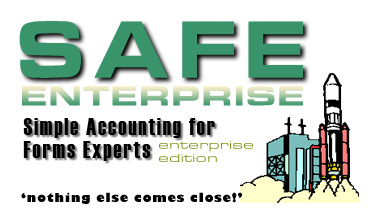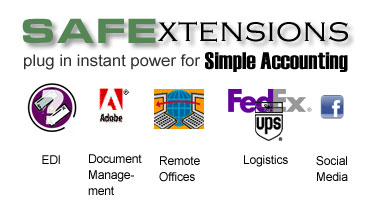Here are some ideas on what kinds of entries to make (and not make) directly into the General Ledger Audit Trail.
Important What Not To Dos!
It may seem strange to start out with what not to do, but the number of entries you need to make into this screen is very small. In fact, if you find yourself using this screen a lot, then something is probably wrong. Heres why:
Closing Entries Are Not Required!
You do not need to make any special closing entries at the end of the accounting period (that is done for you automatically when you run the Period Update task.
You Should Never Make An Entry Directly To The G/L Involving Cash, Sales, A/R or A/P!
The general rule of thumb is this: Let Simple Accounting do the work for you! Many entries that you may think need be made here should actually be made in another part of the program and then posted here automatically by Simple Accounting. Virtually any transaction involving a customer, a vendor, or a bank account should be entered elsewhere. For example, you should never make an entry involving cash directly into the G/L. In every case, the entry should be made by either: Entering a customer payment, writing an A/P Check or making an entry directly into your Check Register.
ENTRIES FLOW FROM SOURCE LEDGERS INTO THE G/L!
Which means that any entries you make directly into the G/L will not affect any source transactions. So if you record a payment as a entry directly into the G/L Cash Account, there will be no trace of it in the Check Register. However, if you enter it into the Check Register, it will correctly flow through to the G/L. Please re-read that last sentence: Entries involving your bank accounts should never be made directly into the G/L. These entries should always be made in the Check Register or A/P Bills Browse. So it is critical that you not make certain entries directly to the General Ledger which are better entered elsewhere.
So What Kind Of Manual Entries Do I Need To Make Here?
You need to enter things like depreciation (amortization) and transfers of assets from one type to another. For example, if you have contributed your own equipment for the running of the business as part of your capital contributions, then you may need to update its current value from time to time to take into account depreciation.
ENTERING STARTING BALANCES
The most obvious time is when you are first setting up Simple Accounting. You create a single transaction to enter your starting balances to the period prior to the accounting period you will be starting Simple Accounting with. Your first transaction will consist of a series of line items: one line item for every account which has a balance at the end of the period prior to starting Simple Accounting. Again, the debits and credits for these line items must be equal. When you are done making these entries, simply press the [Post] button to make them a fixed part of the accounting record.




Help us improve this topic!
You must log in to post a comment.